Apple’s changes to fan management are a retrograde step.
For an index of all my Mac Pro articles, click here.
I have expressed my frustration at Apple’s seemingly mindless and unending tinkering with OS X before. One of the strangest changes was made in the transition from OS X Mavericks to OS X Yosemite (10.9 to 10.10) and it relates to how the OS manages cooling fan speeds. My findings are based on over a hundred data sets and are statistically significant.
Yosemite vs. Mavericks fan management:
Set forth below are two stress test charts from CPU upgrades I performed on 2009 Dual CPU Mac Pros:
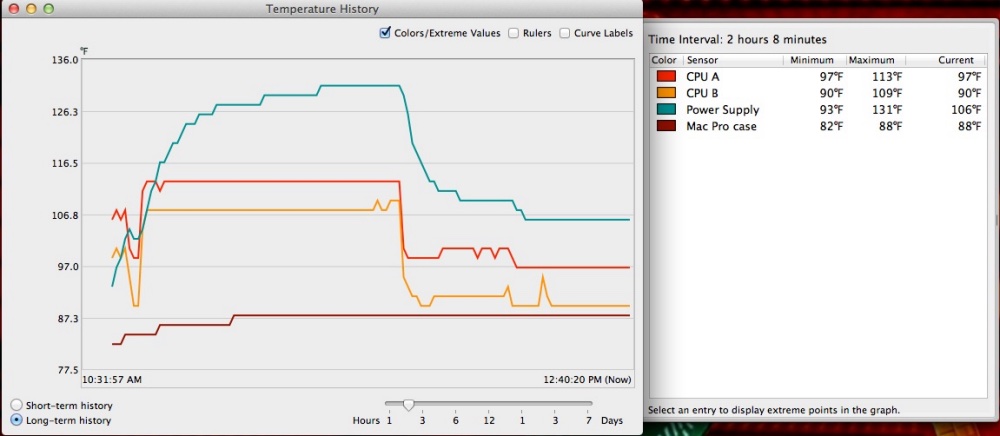
Mavericks stress test.

Yosemite stress test.
These charts display the temperatures of both CPUs (orange and red) as well as the power supply (green) and ambient temperatures (brown) and are logged over a 70 minute cycle during which a stress test utility loads up the CPUs to near 100%.
As you can see, the temperature chart for Yosemite differs dramatically from that for Mavericks (and indeed for earlier versions of OS X, not shown here).
What Apple has done in Yosemite is to set the OS to ramp up the cooling fans far later in the heat cycle than in Mavericks with the result that CPUs (and other cooled devices) get much warmer before the fans speed up, with the minor benefit that less energy is used at idle. (Of course, thinking holistically, your Mac Pro gets warmer and you have to crank up the air conditioning ….) The result is that everything runs hotter (bad) with the sole benefit being that the fans run slower and hence quieter. Awful engineering. A cool electronic component is a happy electronic component. What was Apple thinking of – an increasingly common question when it comes to OS X?
I have repeated the above measurements dozens and dozens of times on any number and variety of CPUs and the results are always the same. The charts above are neither in error nor do they represent statistical anomalies.
Now during normal, low stress use, this is no big deal. Components at idle rarely exceed 115F with only the hot running Northbridge chip (with an operating ceiling of 220F) running at some 125-140F. That is normal. The NB chip is the main ‘traffic cop’ which parcels computing labor out between the two CPUs and if you are wondering why CPU A always runs warmer than CPU B it’s that it also has additional traffic cop duties, so it works harder. The oft stated ‘fact’ that CPU A’s heatsink gets warm air from CPU B’s fan is nonsense propounded by dabblers who fancy themselves engineers – you will get the same differential with a cold Mac Pro as with a warm one, clearly disclosed in the above charts during the warming stage in the first few minutes of stress.
However, under heavy stress it is not exactly a comfort to see CPUs run up to over 160F before the fans spool up (the service limits are variously between 162F – E5520 2.26GHz 80 watt Nehalem 4-core – to 173F – X5690 3.46GHz 130 watt Westmere 6-core). For the technically inclined I am referring to what Intel calls TCASE, which is the temperature at the top of the Integrated Heat Spreader on the CPU. The actual internal components run a good deal warmer than this but TCASE is what the Mac Pro’s sensors measure, so we are comparing apples with err…. Apples. So while it’s fine in normal use to let the OS manage the fans, I recommend manual intervention when high stress use is contemplated.
Fan control utility:
The fan control utility I use to manually override the fans is named Macs Fan Control and it’s a free download, installing itself in the menu bar thus:
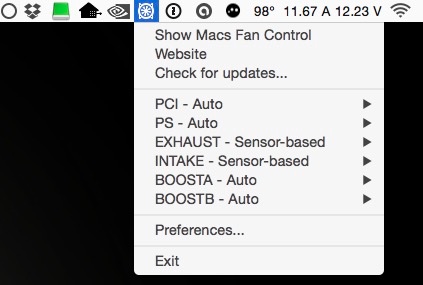
Macs Fan Control
Here’s what the fan names refer to:
- PCI – the large grey fan mounted with two screws on the backplane board which cools the PCIe slot devices (800rpm default)
- PS – the fan in the 980 watt power supply unit (600rpm)
- Exhaust – the rearmost grey fan in the processor cage (600rpm)
- Intake – the frontmost grey fan in the processor cage (600rpm)
- BOOSTA – the fan on the right side of the processor tray when it is removed, cooling CPU A. The CPU fans are buried in the heatsinks and are ordinarily invisible (800rpm)
- BOOSTB – the fan for CPU B (800rpm)
Your Mac Pro will also have one or more fans in the graphics card(s). Those are not shown above.
When freshly installed, Macs Fan Control runs all the fans at the factory defaults shown above – or higher if operating temperatures so dictate. If you are using your Mac Pro under heavy stress (typical in movie and advanced audio processing) I recommend that, as a minimum, you switch Macs Fan Control from Auto to Ambient thus:
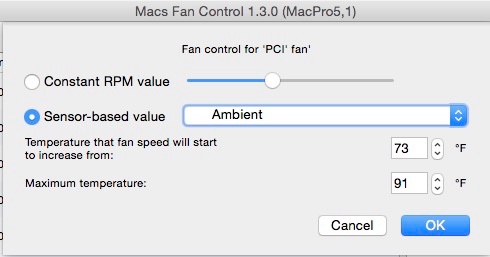
This will adjust the fans to the ambient temperature inside the Mac Pro’s case (generally warmer than your room temperature) based on the related sensor inside the Mac Pro. As components heat up the ambient temperature inside the case rises and the fans will accelerate.
Your settings will look like this and it takes but a few moments to ‘flip the switch(es)’:
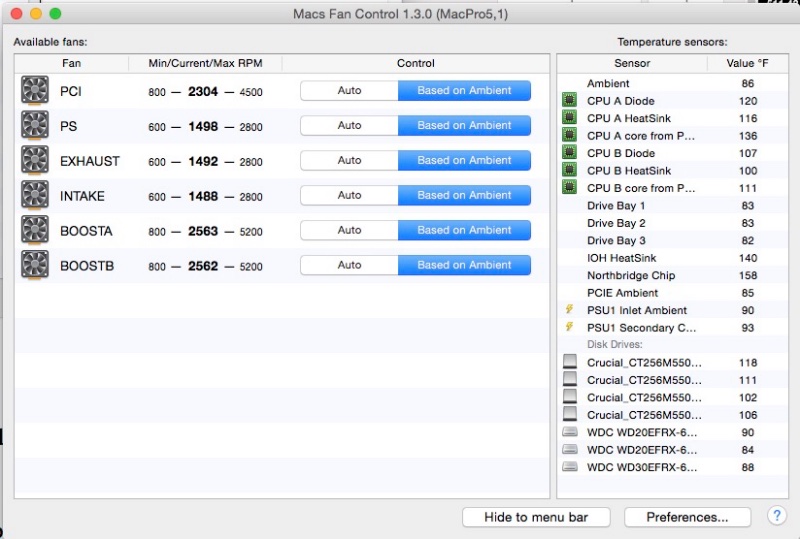
Optimal cooling:noise fan speeds:
In extremely stressful scenarios, I recommend completely overriding fan automation and setting all the fans to at least the settings below:
- PCI – set to 2500, which increases noise from 42 to 46 dB (max is 4500 – 57dB, loud at max)
- PS – set to 1500, 42 to 46dB (max is 2800, 60dB – sounds like a jet engine at max)
- Exhaust and Intake – set to 1500, 42 to 48dB (max is 2750, 60dB – these really roar at max)
- BOOSTA and BOOSTB – set to 3500, 43 to 45dB (max is 5200, 47dB – fairly quiet at max as they are buried within their respective heat sinks)
The noise levels above were measured at four feet from the front of the Mac Pro – a common distance for a machine on the floor next to a desk, and the recommended ‘high stress’ settings above are based on the maximum fan speeds consistent with a tolerable noise level. All the fans ramp up noise significantly as they approach the upper end of their working rpm range.
Here are the fans set in accordance with the above recommendations:
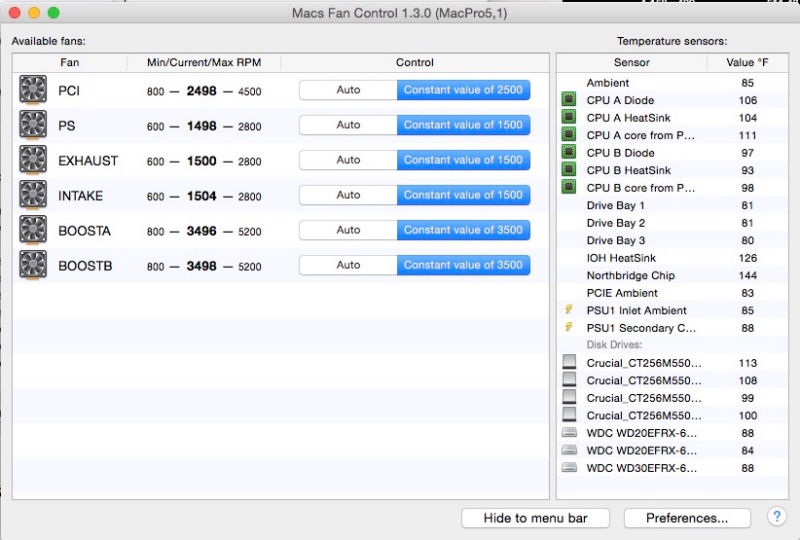
Stress settings for all the fans.
With these override settings, the normal 43dB noise level of the Mac Pro (a whisper) rises to 51dB (clearly audible but not intrusive). Fan wear? Fughedaboutit. Fans are dirt cheap. CPUs are not.
A caution on manual fan speed overrides:
If you use manual overrides for fan speeds there is a potential danger that you will be running your fans too low. For example, if your override sets a fan at 2,500 rpm where the system would ordinarily call for a higher speed, the 2,500 rpm override will prevail meaning that your fan will be running slower than the system would elect. To be safe, then, if using manual overrides check your component temperatures during the most stressful period of use and make sure all is in order. If any temperatures are too high, adjust the overrides for the related fan(s) upward.
How loud is the Mac Pro will all the fans maxed out? Intolerably so at 63dB. It’s an unlikely use case, but if it occurs you really want your Mac Pro is a separate room, well distant from your ears.
Mavericks (and earlier OS X) users do not need to interfere as much, as those versions of OS X have a far smarter approach to fan control, ramping up the fans earlier as the above charts disclose. It bears repeating that the best, leanest, meanest version of OS X ever was Snow Leopard 10.6. You can still buy Snow Leopard 10.6 from Apple for $19.99 and then update it online to 10.6.8, the final version. That version will give you access to the App Store and you will have everything a serious user needs. Later versions – Lion, Mountain Lion, Mavericks and Yosemite add little and, as the above discloses, delete common sense in the case of Yosemite.
Yet another case of form (quiet running) trumping function (keep it cool) in the continuning erosion of common sense in the engineering of OS X.